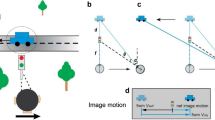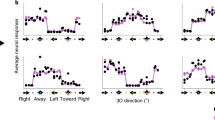Abstract
Visual perception, and by implication underlying neural events, can become unstable when optical information specifying objects is ambiguous. Here we report that one striking form of instability—perceived three-dimensional structure-from-motion (SFM)—can be stabilized when an otherwise ambiguous object appears within a context implying frictional interactions with another rotating object; violations of physical conditions specifying friction disrupt stabilization. Evidently, information about frictional interaction is embedded within neural mechanisms specifying SFM.
This is a preview of subscription content, access via your institution
Access options
Subscribe to this journal
Receive 12 print issues and online access
$209.00 per year
only $17.42 per issue
Buy this article
- Purchase on Springer Link
- Instant access to full article PDF
Prices may be subject to local taxes which are calculated during checkout


Similar content being viewed by others
References
Wallach, H. & O'Connell, D.N. J. Exp. Psychol. 45, 205–217 (1953).
Ullman, S. The Interpretation of Visual Motion (MIT Press, Cambridge, MA, 1979).
Miles, W.R. Am. J. Psychol. 43, 392–405 (1931).
Eby, D., Loomis, J.M. & Solomon, E.M. Perception 18, 427–444 (1989).
Grossmann, J.K. & Dobbins, A.C. Vision Res. 43, 359–369 (2003).
Sereno, M.E. & Sereno, M.I. J. Exp. Psychol. Hum. Percept. Perform. 25, 1834–1854 (1999).
Nawrot, M. & Blake, R. Science 244, 716–718 (1989).
Hock, H.S., Schöner, G. & Giese, M. Percept. Psychophys. 65, 429–457 (2003).
Bradley, D.C., Chang, G.C. & Anderson, R.A. Nature 392, 714–717 (1998).
Orban, G.A., Sunaert, S., Todd, J.T., Van Hecke, P. & Marchal, G. Neuron 24, 929–940 (1999).
Dodd, J.V., Krug, K., Cummings, B.G. & Parker, A.J. J. Neurosci. 21, 4809–4821 (2001).
Sereno, M.E., Trinath, T., Augath, M. & Logothetis, N.K. Neuron 33, 635–652 (2002).
Nawrot, M. & Blake, R. Vis. Neurosci. 6, 219–227 (1991).
Purves, D., Lotto, R.B., Williams, S.M., Nundy, S. & Yang, Z. Philos. Trans. R. Soc. Lond. B. Biol. Sci. 356, 285–297 (2001).
Shepard, R.N. Psychol. Rev. 91, 417–447 (1984).
Acknowledgements
We thank J. Schall and H. Hock for comments on an earlier version of the manuscript and D. Bloom and K. Sobel for helpful discussions. This work was supported by U.S. National Institutes of Health grants EY07135 and EY07760.
Author information
Authors and Affiliations
Corresponding author
Ethics declarations
Competing interests
The authors declare no competing financial interests.
Supplementary information
Rights and permissions
About this article
Cite this article
Gilroy, L., Blake, R. Physics embedded in visual perception of three-dimensional shape from motion. Nat Neurosci 7, 921–922 (2004). https://doi.org/10.1038/nn1297
Received:
Accepted:
Published:
Issue Date:
DOI: https://doi.org/10.1038/nn1297



